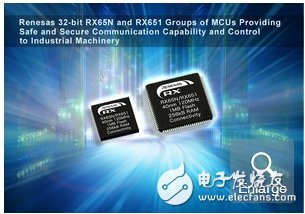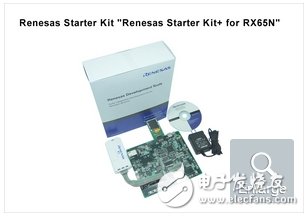Tokyo, Japan, October 13, 2016 - Renesas Electronics Corporation (TSE: 6723), the world's leading semiconductor solutions provider, today announced the RX65N and RX651 series of 32-bit microcontrollers (MCUs). These two types of MCUs will become the new mainstream devices in Renesas' next-generation RX series. The RX65N/RX651 series can be used in various applications such as smart grid concentrators, networked industrial machinery, and building automation. By adopting the RX65N/RX651 two new series of MCUs, system manufacturers can improve the basic performance of the system, and also have the ability to safely rewrite the MCU's built-in storage program on a wireless LAN (WLAN) or Ethernet network. This not only simplifies the development of the terminal equipment, but also facilitates timely modification of the machine settings or control programs, and at the same time flexibly controls the machine to adapt to changes in the installation environment or end user requirements.
With the development of the Industrial Internet of Things and the introduction of the Industry 4.0 standard, the demand for secure network connection equipment used in production environments has also increased. By connecting to the network, manufacturers can monitor the operating status of the machine from within and outside the plant, exchange data, change production instructions, and rewrite MCU stored procedures to update device settings. System manufacturers also need the ability to safely reprogram firmware or data in the MCU's on-chip flash memory to update machine control functions in a timely manner.

Renesas 32-bit RX65N and RX651 series microcontrollers

RX65N with Renesas Starter Kit +
The new RX65N and RX651 series MCUs reduce development effort while simplifying the work of building systems for the Industrial IoT and Industry 4.0 standards.
Key features of the new RX65N and RX651 series microcontrollers:
(1) Using 40nm process, the power efficiency is 5 times that of similar competitors, greatly extending battery running time
System developers require MCUs with high power efficiency, processor performance, and advanced communication features to perform middleware, process sensor data, and control the functions necessary to connect battery-operated devices in a production environment. The new RX65N and RX651 MCUs contain an RXv2 CPU core. The CPU core is manufactured in a 40nm process and the CoreMark® test score is 516 points. The operating current is 15mA (typical) and the power performance is 34.4 CoreMark/mA. This data is 5 times higher than the 32-bit MCU operating at 120MHz (Note 1). With 1MB of flash memory and 256KB of RAM, you can develop software that runs only in internal memory. The built-in memory can hold the software separately for network connection and communication middleware processing of the buffer. This eliminates the need to access external memory and reduces power consumption, which further extends battery life.
(2) Increased performance and new features while supporting the previous generation of MCU control capabilities
The processing performance of the high-performance RXv2 CPU core is 1.3 times that of a 32-bit MCU operating at 120 MHz (Note 1). Thanks to this high processing performance, the new RX65N and RX651 series MCUs, in addition to performing conventional measurement data manipulation and sequence control, can handle communication functions and additional functions that utilize network connections.
The new RX65N and RX651 series MCUs retain the communication capabilities of previous generations such as the Ethernet, USB, CAN, UART, SPI and I2C functions of the RX63N and RX631 series. Both MCUs have achieved good track records in a variety of industrial machinery applications. In addition, the new MCU implements a WLAN module connection via an SD host interface with 4-bit data communication capability and a four-serial peripheral interface to support serial flash connections. To manage all the necessary communication stacks, 256KB of embedded RAM can be used to solve the buffering problem.
AES (Note 2) and TRNG (Note 3) hardware modules can be used to encrypt and decrypt communication data to ensure the security of network data transmission. This family of microcontrollers features zone protection. This function performs overwrite protection on specific areas when the program on the on-chip flash is updated, thereby preventing the flash program from being erroneously overwritten.
Thanks to the above functions, the new MCU can guarantee the security of network communication and realize the reliability of program adaptation, avoiding erroneous data rewriting. Therefore, system manufacturers can use cloud computing or fog calculation to obtain feedback information from AI functions, program adaptation through the network to update machine settings or control functions in a timely manner, or update machine control functions according to the requirements of end users to cope with changes in the installation environment. .
(3) Reduce development time by approximately 20% and help to enter the market in a timely manner
In addition to providing MCUs that are highly compatible with early RX family members, compilers, debuggers, code generation tools, and flash programmers, Renesas also offers a comprehensive integrated development environment (IDE). At the same time, Renesas also offers a wide range of software examples and drives, including firmware integration technology (FIT) drivers. FIT technology is a new concept. It emphasizes the simplification of embedded peripheral function module drivers and improves portability between RX series MCUs, ensuring easy migration into and out of existing products supporting FIT technology by providing common API functions. Device drivers and middleware can be combined with sample source code and used in development processes to implement peripheral functions supported by code generation tools. Tools that link to the IDE (such as e2studio) can be used to update and reference files that describe internal FIT modules, instructions, technical updates, etc., resulting in greater flexibility during development. This means that device drivers and middleware can be developed faster, reducing the overall system development effort by approximately 20%, ensuring that the system can enter the market in a timely manner.
Ipad Battery,Ipad Air Battery,Ipad Pro Battery,Ipad Replacement Battery
Shenzhen Sunwind Energy Tech Co.,Ltd , https://www.sunwindbatterylm.com
